In the past four years, the Harvard South Asian Association has aimed to educate audiences about Indian classical dance with its productions of “Kalpanam.” This Saturday in Lowell Lecture Hall, the show will also include a taste of Bharatha Natyam, a classical South Indian form of dance drama.
“What this show holds is not only new for us on campus, but marks a new trend in the production of the dance form globally,” says Amrapali Maitra ’10, who directed last year’s performance. “They are exploring the dance form in similar ways as professionals are in India.”
“Kalpanam” brings together professional-caliber dancing with a story that speaks to new audiences. Maitra admires the craft and creativity that the production’s group of dancers bring to the stage.
“A two-hour classical dance drama in India would be choreographed by a dance teacher who will focus on that only for months,” she says. “Here we have less time, while also working on academics. It’s a very intensive process, but the creativity is remarkable.”
The show will contain nine vignettes depicting the “Navarasa,” the moods of love, compassion, fury, fear, wonder, disgust, peace, humor, and valor. Instead of focusing on Hindu mythology, the directors have chosen stories and concepts from many different cultures and time periods. Helen Keller, the resurrection of Jesus Christ, child labor, and King Ashoka all make it into the show.
Bharatha Natyam as a dance style facilitates storytelling in two ways, through its pure dance elements (“nritta”) and its expressionistic elements (“abhinaya”). “It’s about the range of human emotion,” says co-director Aditi Sen ’09. “We just want to show how dance can be extremely moving, and in different ways. It’s not just moving in sheer beauty, but also through subject matter.”
Co-director Prerna Martin ’09 wants to show the audience the full range of Bharatha Natyam’s potential. “This year we’re trying something that’s not [conventional],” Martin says. “This art form can carry a lot. You’ve seen one side for the past two or three years, but let’s show you a few more things you might not have expected.”
The accessibility of these emotions for an audience of Harvard students is one of the driving forces behind the departure from Indian mythology. Although narration will be provided before each dance and a program will be handed out with detailed explanations of the dance elements and the storyline, Martin noted that in the past there were moments that could be hard for the audience to follow. She hopes that the new grounding in historical events, contemporary social issues, and everyday stories will increase the audience’s overall understanding.
Although the SAA holds several Indian cultural dance performances each year, Martin notes that “Kalpanam” brings a new perspective. “From what I have seen from students and faculty members who’ve been attending regularly, it’s just something genuinely different from the other South Asian dance shows on campus.”
“Kalpanam” is also important as a venue for dancers trained in the classical style to continue to perform in college. It serves as a forum for them to share this part of their culture with the community. In portraying universal themes through an evocative traditional art form, the creators of “Kalpanam” hope to continue to broaden its audience beyond its devoted following.
“Kalpanam,” which means “imaginings,” stays true to its name as the directors continue to discover new ways of interpreting stories and engaging the audience. “We really consciously try every year to do something that we’ve never done before...so the audience can see a wide variety of things,” Martin says. “This year I think it’s come into play more than any other year.”
—Staff writer Melanie E. Long can be reached at long2@fas.harvard.edu.
Multimedia
Read more in Arts
SPOTLIGHT: Jeremy R. Steinemann '08














